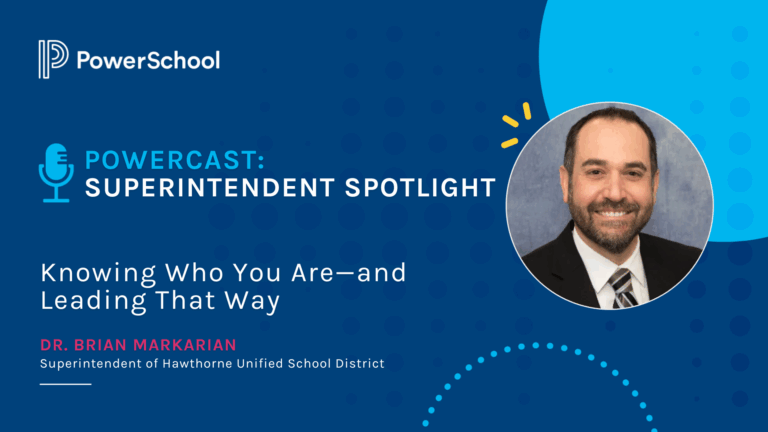As school communications continue to evolve, it is time for school leaders to re-think social media strategy. School sites and districts have begun to adopt social media platforms to share information, but school leaders also need to build a visible professional presence. The good news is that you are guaranteed to build trust and see higher levels of community engagement – but only if you do it right.
1. Addressing goals and values
As school communities continue to grow with participants for whom social media is ubiquitous to life, there has been a huge increase in the expected level of accountability and transparency that the public expects from businesses, schools, and institutions. Principals, superintendents, and other education leaders risk the trust, commitment, and support of their community if they are not utilizing digital connections to quickly share information, promote educational programs, listen to and engage with stakeholders, and establish the two-way channels of communication that Generation X and Millennials have come to expect.
The first step is to set some very specific goals. You don’t have to do everything at once, so consider your biggest priorities – vague goals like “raising awareness” will not allow you to maximize the potential of social media. Make a list of measurable outcomes with deadlines and don’t shy away from directly stating your goals for your audience. It may help clarify to parents and stakeholders how you plan to use social media and what they can expect.
Don’t worry too much about brand-building and self-promotion until you have established a solid media presence. Otherwise, you risk seeming inauthentic. Authentic language means being brave when tackling tough topics, participating in varied discussions, using appropriate humor, sharing your expertise, and establishing yourself as a unique and human voice, all with your goals in mind.
Many of the leadership tips we have previously discussed are also essential to becoming an influential presence on social media.
2. Building your strategy
Start building your strategy by deciding which social media networks you, your district, or your school site will utilize. Spreading yourself thin across Facebook, Instagram, Twitter, LinkedIn, Pinterest, Tumblr, WordPress, Medium, and YouTube is unnecessary. Choose one or two sites that resonate best with your stakeholder demographic and decide what you want out of the platforms. For example, Twitter is best for news dissemination, establishing a voice on specific issues and hot topics, while Facebook is a great place to engage with your school community. Instagram builds your brand while on LinkedIn, you can establish yourself as a thought leader in 500 words, with added resources.
Think outside the old model of press releases and letters home in student’s backpacks. Let your community get to know its education leaders while building a connection to your district. Consider starting a podcast or weekly video vlog – YouTube is the world’s largest search engine and people naturally gravitate toward engrossing video and image content. You can even utilize smartphone apps to send out blurbs and event reminders to parents, or even as communication tools for teachers.
When building your strategy, remember that engagement and discussion are much more important than just building up a large following. Engagement builds trust, and that is the most valuable thing you can have in a community.
3. Developing best practices
Watch out for political posts unless they were sanctioned by your district. If you write about politics on a personal account, use appropriate language, don’t follow colleagues, cite and check your sources, and do not make work references.
Some reminders:
- A tweet from an account identifying the speaker as an educator at a particular school/district may lead to discipline or termination if it could potentially damage the employer.
- Speech is protected if related to collective bargaining and working conditions.
- Most issues resulting in discipline come from interaction online with students or posts that are inappropriate for students to see. Never joke about students, use offensive humor, or make posts that could create a hostile work environment for co-workers and district personnel.
3. Assembling a team
Like your community engagement strategy, your social media campaign duties should not be shared amongst the entire staff. Instead, a social media manager or a small group should work in unison with clearly outlined goals, utilizing organizational tools such as:
An Engagement Policy: In compliance with district policies, your social media team needs guidelines for posts and correspondence. This can include rules about photography, language, announcements, measures taken for student protection, and sharing posts. Having a clear policy sets boundaries and establishes consequences for possible misuse of social platforms. Edutopia provides some links for researching existing policy.
A Social Media Calendar: If you or your team plan outposts, any possible problems are likely to be caught before they are published for the world to see. Planned posts allow you to establish a stream of related content, make simultaneous announcements, easily manage questions and contests, and stay consistent for your target audience by posting at the same time each day. Check out tools like TweetDeck and HootSuite that make scheduling easy.
4. Engaging the audience
Parents, teachers, and education leaders are all different audiences. Decide why you want to use social media to talk to them. To establish yourself as an expert? To build community? To discuss timely topics? Each of these goals requires individual methods. For example, hashtags on Instagram and Twitter give you access to existing conversations, while tagging users on Twitter or Facebook invites them to your post.
Lead a Twitter chat to moderate a discussion, like ACSA’s #LadiesWhoLead Twitter chat (the last Tuesday of every month), or start an informative blog. Running Facebook ads and “boosting” posts are highly effective audience targeting methods. Your “about me” or biography should include links to your website.
On every platform, ALWAYS respond to messages. Facebook users see your response rate and trust you more if it is high. Plus, parents will use the platform to ask quick questions in a way that feels more collegial than an arranged, in-person meeting. You should also follow accounts that are likely to follow you back. Again, be mindful of who you engage with and indirectly endorse by sharing their posts.
Eric Sheninger, Principal or New Milford High School in New Jersey, told Education World:
“As a high school principal, one of the greatest benefits of using social media has been connecting with stakeholders by delivering real-time information on student achievements, staff innovations, athletic scores, meetings and important updates to our school website… the school has benefited from an impactful PR platform by delivering news and content through tools that our students, parents, and community members use on a routine basis at home. This powerful combination has led to the establishment of a positive brand presence.”
Second, only to a district’s website, social media has the highest rate of successful community engagement. In a 2016 study, implementation of social media strategy was the #1 reason for more profitable outreach in respondents’ districts. All of the major platforms, especially LinkedIn, can be used to tag or message community leaders or lawmakers, giving administrators the chance to see new faces and set the groundwork for mutually beneficial relationships.
5. Building a reputation
Social media is an excellent tool for combating negativity, so set a positive tone by posting success stories related to your district or commentary on events like arts, holidays, and sports.
A great reputation rests upon reliability and relatability. Cite and check any sources that you reference and write in an honest, informed tone. Let your account serve as a source of community pride and local education news. Raise interesting questions and ask for audience opinions – a compelling conversation is a good way to grab someone’s attention while they are scrolling, then direct them to your poll, website, or goal (i.e. fundraising).
An aspect of a reliable social presence is to not annoy the audience with 5 posts a day. Social media is something like a portfolio of your work; if a post seems dull or repetitive to you, it certainly won’t make anyone else stop scrolling to read more. Use visuals, which the brain processes faster and with more interest than it does text. Keep content concise, fresh, and unique to your community, so that you add value to someone’s day and do not seem to just be pushing an agenda.
Novelty in your posts might include showing parents how events are planned, asking for opinions on current events, showcasing alumni success, Humans of New York style quotes and personal profiles, day-of-the-week themes, a “day in the life” of a staff member, polls, educational tips, lighthearted viral videos, or honoring community service participants. Ask parents to send in photos or fun classroom ideas. Start conversations about students’ goals, or the next summer or winter break.
6. Using data
In social media endeavors, the power of data is unquestionable. Numbers turn on the light in the darkness, showing you who is most interested in what content, at what time of day and week, how successful you are at getting posts read and shared, and if you are directing readers to your website.
To rank higher on search engines, let metrics help you place keywords and use other SEO techniques. Put in the time to research the most successful keywords for your topic, and it will pay off.
Some important, successful results that come from measurement: quick crisis response time, program growth, positive reputation management, more clarity and consensus with your audience, sense of accessibility by stakeholders, and direct, immediate feedback by stakeholders.
In “Managing Your Brand With Social Media,” ACSA President Lisa Gonzales and Communications Content Specialist Darcy Totten present the basics, tools, and best practices for better controlling your online reputation and designing an eye-catching, authentic, authoritative digital presence.




























